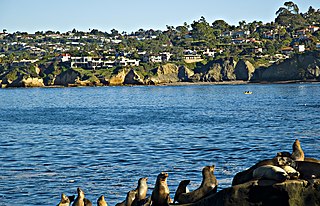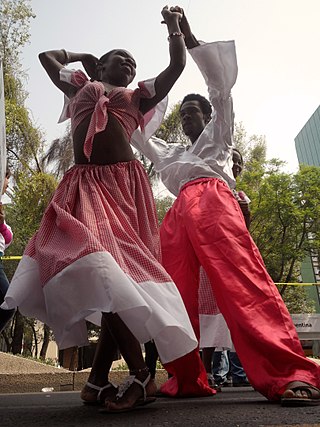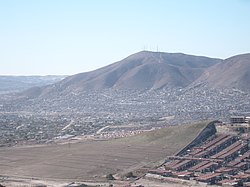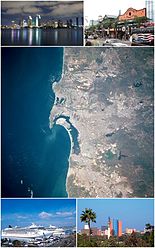
Chinatown is the catch-all name for an ethnic enclave of Chinese people located outside Greater China, most often in an urban setting. Areas known as "Chinatown" exist throughout the world, including Europe, Asia, Africa, Oceania, and the Americas.

Mexicali is the capital city of the Mexican state of Baja California. The city, which is the seat of the Mexicali Municipality, has a population of 689,775, according to the 2010 census, while the Calexico–Mexicali metropolitan area is home to 1,000,000 inhabitants on both sides of the Mexico–United States border. Mexicali is a regional economic and cultural hub for the border region of The Californias.

This article discusses Chinatowns in the Americas, urban areas with a large population of people of Chinese descent. The regions include: Canada, the United States, and Latin America.
Chinatowns in Latin America developed with the rise of Chinese immigration in the 19th century to various countries in Latin America as contract laborers in agricultural and fishing industries. Most came from Guangdong Province. Since the 1970s, the new arrivals have typically hailed from Hong Kong, Macau, and Taiwan. Latin American Chinatowns may include the descendants of original migrants — often of mixed Chinese and Latino parentage — and more recent immigrants from East Asia. Most Asian Latin Americans are of Cantonese and Hakka origin. Estimates widely vary on the number of Chinese descendants in Latin America but it is at least 1.4 million and likely much greater than this.

Urban Chinatowns exist in several major European cities. There is a Chinatown in London, England, as well as major Chinatowns in Manchester, Birmingham, Newcastle and Liverpool. In Paris there are two Chinatowns: one where many Vietnamese – specifically ethnic Chinese refugees from Vietnam – have settled in the Quartier chinois in the 13th arrondissement of Paris which is Europe's largest Chinatown, and the other in Belleville in the northeast of Paris. Berlin, Germany has two Chinatowns, one in the East and one in the West. Antwerp, Belgium also has an upstart Chinese community.
Chinese Cubans are Cubans of full or mixed Chinese ancestry who were born in or have immigrated to Cuba. They are part of the ethnic Chinese diaspora.

San Diego–Tijuana is an international transborder agglomeration, straddling the border of the adjacent North American coastal cities of San Diego, California, United States, and Tijuana, Baja California, Mexico. The 2020 population of the region was 5,456,577, making it the largest bi-national conurbation shared between the United States and Mexico, and the second-largest shared between the US and another country. The conurbation consists of the San Diego metropolitan area, in the United States and the municipalities of Tijuana, Rosarito Beach (126,980), and Tecate (108,440) in Mexico. It is the third most populous region in the California–Baja California region, smaller only than the metropolitan areas of Greater Los Angeles and the San Francisco Bay Area.

Barrio chino is a neighborhood in Lima, Peru that is centered on two blocks – 7 and 8 – of Jirón Ucayali in downtown. The neighborhood was founded in the mid-19th century by Chinese immigrants, but it was heavily damaged in the late 19th century by the War of the Pacific and further declined in the following decades. It experienced a revival starting in the 1970s and is now a thriving resource for Chinese-Peruvian culture.

Calafia Airlines, legally Calafia Airlines S.A. de C.V. is a Mexican regional airline based in Cabo San Lucas, Baja California Sur, Mexico. It operates regular flights to the Baja California Peninsula, the Mexican Pacific coast and Northern Mexico, in addition to charter flights and tours. Its main hub is Cabo San Lucas Airport and has focus city operations in La Paz and Loreto. It operates a fleet consisting of Embraer regional jet aircraft. It is named after Calafia, the legendary warrior queen of the island of California.

Barrio Chino is a barrio located in the downtown area of Mexico City, near the Palacio de Bellas Artes. The neighborhood is located on two blocks of Dolores Street and consists of a number of restaurants and businesses that import goods. The neighborhood consists of approximately 3,000 families with Chinese heritage in Mexico City.

Chinese immigration to Mexico began during the colonial era and has continued to the present day. However, the largest number of migrants to Mexico have arrived during two waves: the first spanning from the 1880s to the 1940s and another, reinvigorated wave of migrants arriving since the early 21st century. Between 1880 and 1910, during the term of President Porfirio Díaz, the Mexican government was trying to modernize the country, especially in building railroads and developing the sparsely populated northern states. When the government could not attract enough European immigrants, it was decided to allow Chinese migrant workers into the country. At first, small Chinese communities appeared mostly in the north of the country, but by the early 20th century, Chinese communities could be found in many parts of the country, including the capital of Mexico City. By the 1920s, the number of Chinese in the country was about 26,000.

La Chinesca is a neighborhood located in the Mexican city of Mexicali. The location is home to about 15,000 people of Chinese origin, historically the largest Chinese community in Mexico. However, as of 2012, this number was surpassed by Tijuana's La Mesa District which is home to approximately 15,000 Chinese immigrants and people of Chinese descent. While this number does not compare to other cities worldwide with a prominent Chinese diaspora, early in the 20th century Mexicali was numerically and culturally more Chinese than other immigrant groups. The Chinese arrived to the area as laborers for the Colorado River Land Company, an American enterprise which designed and built an extensive irrigation system in the Valley of Mexicali. Some immigrants came from the United States, often fleeing anti-Chinese policies there, while others sailed directly from China.

Buenos Aires' Chinatown, locally known as Barrio Chino, is a largely commercial section about five blocks long in the barrio of Belgrano, Buenos Aires. The Asian community living in Belgrano is less than 0.5% of the ward's total. Despite the designation of this Belgrano enclave as a Chinese ethnic enclave, the area is populated by different Asian communities, with a predominance of Taiwanese people and, to a lesser extent, Thais.

The Chinese community in the Dominican Republic forms one of the largest Chinese communities in Latin America. As of 2012, there are over 3,600 recorded Chinese-born Dominican residents. Although no official census has been made, there are estimates of approximately 60,000 people of Chinese origin living in the country. Chinese descendants living in the Dominican Republic may be referred as Chinese Dominicans.

Chinatowns are enclaves of Chinese people outside of China. The first Chinatown in the United States was San Francisco's Chinatown in 1848, and many other Chinatowns were established in the 19th century by the Chinese diaspora on the West Coast. By 1875, Chinatowns had emerged in eastern cities such as New York City, Boston, and Philadelphia. The Chinese Exclusion Act of 1882 barred Chinese immigration to the United States, but the Magnuson Act of 1943 repealed it, and the population of Chinatowns began to rise again. In the 2010s, the downturn in the U.S. economy caused many Chinese Americans to return to China.

Asian Mexicans are Mexicans of Asian descent. Asians are considered cuarta raíz of Mexico in conjunction with the two main roots: Native and European, and the third African root.

There is a large Haitian diaspora in Mexico. According to a 2021 report, there are approximately 71,559 Haitian-born people living in Mexico.
Viaducto Piedad is a colonia in the Iztacalco borough of Mexico City, Mexico. Its name comes from Viaducto Miguel Alemán, a primary thoroughfare in Mexico City, and from the former De la Piedad River, which now runs in a culvert underneath the highway. It is served by the Viaducto metro station of the Mexico City Metro.















